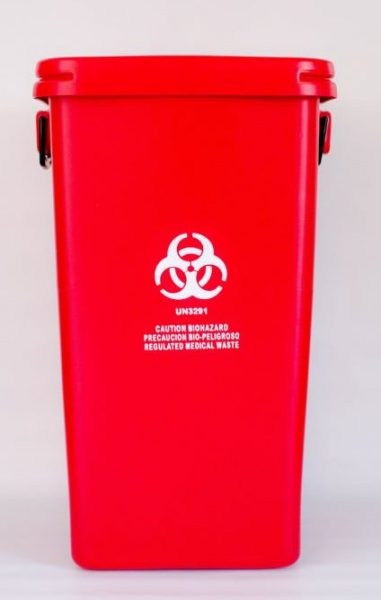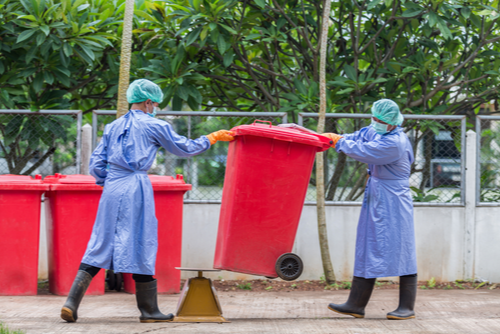Security First: Your Guide to Accountable Medical Waste Removal Services
The Value of Correct Clinical Waste Disposal: An Overview for Health Care Facilities
Appropriate medical waste disposal is a critical element of healthcare facility monitoring, making certain the security and wellness of people, team, and the environment. From comprehending the various classifications of clinical waste to following regulative requirements, health care facilities should take on effective waste partition practices and select suitable disposal techniques. However, the importance of correct clinical garbage disposal goes past mere conformity; it is a duty that requires ongoing training and education for staff. In this overview, we will certainly discover the different facets of medical waste disposal and highlight the vital actions that healthcare facilities must take. By implementing these methods, medical care centers can alleviate dangers, shield public health, and contribute to a cleaner, much safer environment.
Understanding Clinical Waste Categories
Understanding medical waste categories is important for appropriate disposal in medical care centers. Medical waste is a wide term that incorporates various kinds of waste generated in health care setups, such as centers, hospitals, and research laboratories. Categorizing clinical waste helps make sure that it is handled, stored, and disposed of securely and based on relevant regulations.
There are a number of categories of medical waste that health care facilities require to be mindful of. These categories consist of contagious waste, sharps waste, pharmaceutical waste, chemical waste, and contaminated waste (medical waste disposal services with WasteX). Each classification has certain qualities and requires various disposal techniques to lessen the danger of injury to medical care workers, individuals, and the atmosphere
Transmittable waste, as an example, refers to waste infected with potentially transmittable materials, such as blood, body liquids, and tissues. Sharps waste consists of needles, syringes, and other sharp things that can create injury or transmit infections. Pharmaceutical waste contains ended or extra medications, while chemical waste consists of harmful chemicals used in medical procedures. Radioactive waste consists of materials polluted with radioactive compounds, such as nuclear medicine materials.
Compliance With Regulatory Demands
Health care facilities have to make sure conformity with regulatory requirements for correct clinical garbage disposal. Regulative bodies, such as the Environmental Protection Company (EPA) and the Occupational Safety And Security and Wellness Administration (OSHA), have established regulations and guidelines to secure public health and wellness and the setting. These policies describe the appropriate handling, storage, transport, and disposal of clinical waste.
Compliance with regulatory requirements is essential for healthcare facilities to stay clear of legal penalties, reputational damage, and potential damage to human health and wellness and the atmosphere. Failure to abide by these regulations can result in penalties, suits, and also the suspension or cancellation of running licenses.
To make certain compliance, healthcare centers must develop comprehensive waste monitoring programs that consist of personnel training, appropriate waste segregation, and using ideal containers and labels. Routine audits and inspections ought to likewise be carried out to identify any kind of non-compliance issues and resolve them immediately.
It is vital for healthcare facilities to keep up to day with adjustments in regulations and update their waste administration practices appropriately. This can be attained by proactively keeping track of updates from governing bodies and getting involved in training programs and workshops.
Carrying Out Effective Waste Segregation Practices
To make sure appropriate clinical waste disposal, medical care centers must apply reliable waste partition methods. Waste partition is a vital step in the total waste management process, as it assists decrease the risk of infection, protects against cross-contamination, and ensures the secure disposal of different sorts of waste. Efficient waste segregation methods entail dividing medical waste right into various groups based upon its qualities and potential risks.
One typical method is the segregation of sharps waste, such as scalpels and needles, from other sorts of clinical waste. Sharps waste must be put in puncture-resistant containers to avoid injuries and prospective infections. Furthermore, unsafe waste, such as chemicals and pharmaceuticals, ought to be separated from More about the author general medical waste to prevent ecological contamination.
Appropriate labeling and color-coding of waste containers are necessary for effective waste partition. Noticeable and clear tags need to be placed on each container to show the sort of waste it has and any kind of special delivery needs - medical waste disposal services with WasteX. Furthermore, color-coding can be utilized to separate in between different waste categories, making it much easier for healthcare staff to get rid of and determine of waste appropriately
Normal training and education for medical care personnel is critical for the effective implementation of waste segregation methods. Personnel should be informed on the various waste categories, correct partition techniques, and the value of complying with waste management protocols. This will certainly assist make sure conformity and uniformity in waste partition practices throughout the center.
Deciding On Appropriate Disposal Methods
Appropriate choice of ideal disposal methods is vital in making sure the environmentally responsible and risk-free administration of medical waste in health care centers. Medical care facilities produce a range of medical waste, consisting of sharps, transmittable waste, pharmaceutical waste, and chemical waste - medical waste removal near me. Each kind of waste needs specific disposal techniques to reduce the risk of contamination, injury, and environmental injury
One usual disposal technique for medical waste is incineration. Incineration involves the regulated burning of waste at heats. This technique works in destroying pathogens and lowering the quantity of waste. Nonetheless, it can release damaging pollutants right into the air otherwise correctly controlled.

Chemical disinfection is an additional technique made use of for specific kinds of clinical waste, such as pharmaceutical waste. This method uses chemicals to neutralize or ruin impurities. Nonetheless, it is necessary to pick chemicals that are eco friendly and risk-free.
In some instances, land fill disposal may appropriate for non-hazardous medical waste (medical waste disposal services with WasteX). Nonetheless, correct partition and packaging are essential to stop leakage or contamination.
Ultimately, medical care centers must very carefully examine the characteristics of their medical waste and choose appropriate disposal methods that prioritize safety and security, ecological security, and regulative conformity. Normal training and monitoring are necessary to make sure that health care personnel follows appropriate disposal protocols.

Training and Educating Staff on Correct Disposal Procedures
Staff education and training play a vital duty in making certain the appropriate disposal of clinical waste in healthcare facilities. It is important that all employee, consisting of medical professionals, registered nurses, specialists, and support staff, get detailed training on appropriate disposal procedures. This training needs to cover the different types of clinical waste, their prospective risks, and the proper methods for handling, segregating, and dealing with them.
One of the primary objectives of personnel education and learning and training is to ensure that all health care professionals comprehend the relevance of correct disposal treatments and the prospective effects of improper waste monitoring. They need to be familiar with the risks associated with medical waste, such as the transmission of infections and the contamination of the atmosphere. medical waste removal services. By comprehending these dangers, personnel will certainly be a lot more motivated to follow appropriate directory disposal procedures and take the necessary safety measures to protect themselves, their coworkers, and the area
Educating must likewise cover the Full Article usage of personal protective tools (PPE) and the correct techniques for handling clinical waste. Personnel need to be enlightened on just how to identify and set apart various sorts of waste, such as sharps, infectious waste, and hazardous chemicals. They need to also be trained on the correct use of waste containers, such as sharps containers and biohazard bags, as well as the value of labeling and securing these containers correctly.
Moreover, team education and training must consist of normal updates and refresher course programs to make certain that healthcare specialists remain informed concerning the most recent policies and ideal methods in medical garbage disposal. This continuous education and learning is essential to preserve a high level of awareness and compliance amongst team member.
Verdict
Finally, appropriate medical garbage disposal is of utmost significance for health care centers. Understanding the various categories of clinical waste and adhering to regulative requirements guarantees the security and well-being of both healthcare employees and the basic public. Implementing effective waste segregation practices and picking ideal disposal methods are vital in stopping the spread of transmittable illness and shielding the setting. Training and enlightening staff on appropriate disposal treatments is important for keeping a secure and clean medical care center.
From understanding the various groups of medical waste to conforming with regulative needs, health care facilities have to embrace reliable waste partition methods and pick appropriate disposal techniques. These categories include transmittable waste, sharps waste, pharmaceutical waste, chemical waste, and contaminated waste.To guarantee proper clinical waste disposal, medical care centers must execute reliable waste segregation techniques. Waste partition is a vital action in the overall waste monitoring process, as it helps lessen the danger of infection, avoids cross-contamination, and makes sure the secure disposal of various types of waste. Healthcare centers generate a variety of medical waste, consisting of sharps, transmittable waste, pharmaceutical waste, and chemical waste.